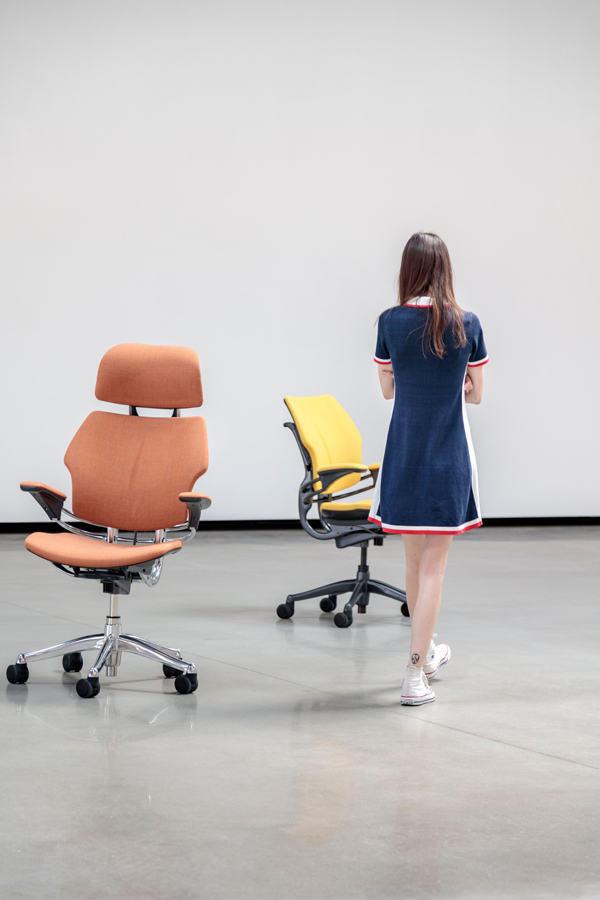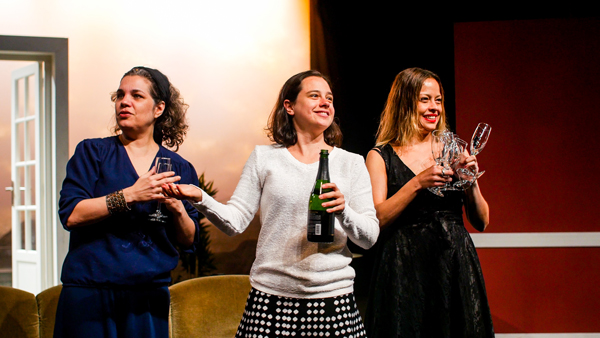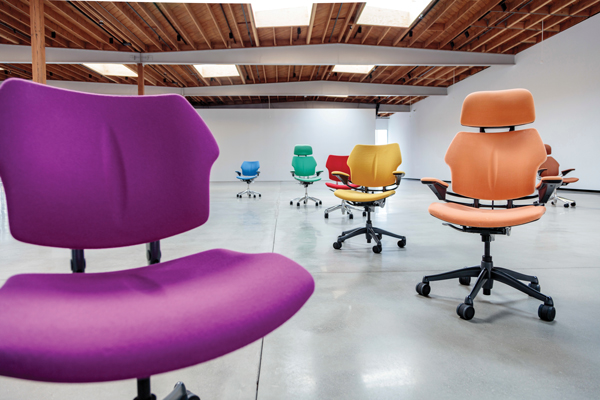Artificial Intelligence Gets Uppity
The future is closer than we think. Yours Truly has been binge-watching the series Humans on Amazon Prime, which has a remarkable cast playing “Synths,” or Synthetics, in a future-world where AI androids take over the menial and boring jobs none of us want to do. Gemma Chan, as Anita/Mia, is the soul leader of the group in which consciousness has been instilled by their maker… Okay, this is actually an intro to my visit to Urs Fischer’s “Play” at Jeffrey Deitch in Los Angeles, where I came upon the emptied-out gallery space filled with nine office chairs rolling about on their own. At first they seem amusing contraptions, but after about 10 minutes you, as an observant sort, begin to notice patterns. First, they don’t crash into the columns or the walls or you. Then, they seem to be aware of you—the blue one began to stalk me, moving with me as I stepped to the side. Again and again. I wasn’t sure whether this cheeky piece of furniture was herding me, or inviting me to dance.

At other times, I saw two “face” one another and do a little minuet, and now and then they would all kind of line up in a chorus line. (Choreography was by
Madeline Hollander.) Sometimes one would disappear into a corner room. When I followed, I found their secret—a recharging station. This afternoon a gallery assistant was manually replacing the seat cushion where their battery lies. “Normally, they would just go in here,” he pointed towards a recharging booth, “and automatically get a new cushion, but something’s wrong with it, so I have to do it.” Just like the Synths, I thought, who go to charging stations (usually just a cable plugged into their ribs) when they know their charge is running down. Later I chatted with another gallery assistant, who told me about a chair that tried to run away. “This one actually tried to get out the door. Someone had to block the way before it rolled into the street!” Ah, tis the way with AI machines! If you’ve been watching Humans, you know they begin to get ideas of their own.

Alice Könitz, Domestic Pavilion, COLA 2019, installation image, photo by Jeff McLane.
COLA Grants
Every year the City of Los Angeles hands out a dozen-plus grants to artists to produce a new body of work. It’s worth $10,000, and the main requirement is to participate in an exhibition at the Municipal Art Gallery in the Barnsdall Art Park the following year. COLA 2019 (through July 14) features last year’s recipients, and they’re an impressive lot. I’ll just cite two whose work exemplifies the kind of dedication and thoughtfulness which I find compelling.
Enrique Castrejon creates fragmented human forms, attached to the wall and held in an intricate web made up of strips of paper. Upon the strips are stats and statements taken from health studies and reports about HIV and STD among African American and Hispanic/ Latino men. The artist has worked at the LA LGBT Center for over 15 years, so the work reflects his concerns in his other occupation, as well. It may be difficult to read the text, but the work allows the bodies to dance across the wall, and the crisscrossing strips feel like networks they are floating in.
Sabrina Gschwandtner makes what looks like patchwork quilts placed against a light box—in actuality her “material” are film strips, woven into patterns with polyester line threaded through the sprockets. In the three works included in the exhibition, she focusses on women’s history in cinema. One, for example, includes strips taken from The Curse of Quon Gwon: When the Far East Mingles with the West (1917) by silent filmmaker Marion E. Wong—it’s the first American film to feature an all-Chinese (or Chinese American) cast.

Mark Murphy of REDCAT, photo by Gary Leonard.
Comings and Goings
As mentioned in my last Shoptalk, The Good Luck Gallery in Chinatown is closing after five remarkable years, sadly. However, gallery founder Paige Wery just announced a new collaboration with the nonprofit organization Tierra del Sol, based in Sunland-Tujunga. They’re taking over the lease at the Chungking Road gallery, with Wery staying on as gallery director and curator.
The Tierra del Sol Foundation helps adults with disabilities through various workforce development programs, which includes two art studios. So the new gallery will highlight work from these artists, as well as others. Wery says she’s thrilled to join their efforts, “to continue working with and showing artists outside the mainstream.” Launch date for the new joint venture is July 27. Sounds like a great match.
Welcome to Bethany Montagano as new director of the Pacific Asian Museum in Pasadena! In May she took over the position left vacant with the departure of Christina Yu Yu last year, and during a welcome reception in early June, she pledged to lead with her values. She announced an initiative to put together a show featuring contemporary Asian American artists, such as Gajin Fujita, who was present. Montagano came from a stint as senior curator at the Skirball Cultural Center, and has a PhD in American History and a BA in Asian Studies.
Farewell to Mark Murphy, founding executive director of REDCAT, stepping down from his position in June after 16 extraordinary seasons. REDCAT, the small theater connected to Disney Hall, has been one of the few venues in Los Angeles regularly presenting theater, dance and other forms of performance that was experimental, cutting edge, sometimes daringly esoteric and often very good. Under Murphy, they presented some 150 productions, with performers from all over the U.S. as well as 70 countries.

sabel Teixeira (Olga), Julia Bernart (Irina) and Stella Rabello (Maria) in Christiane Jatahy’s What if they went to Moscow?, at REDCAT, photo by Vanessa Crocini.
As you may surmise, Yours Truly has been a big fan of REDCAT. This season alone I saw a moving retelling of Auschwitz, the death camp run by Nazis, in Kamp by the Dutch company Hotel Modern. They used miniature puppets and sets and mobile video cameras. It was shockingly, movingly brilliant. The theater also mounted Christiane Jatahy’s What if They Went to Moscow, based loosely on Chekhov’s Three Sisters and performed simultaneously as a live action play and a projected video, where the audience literally got multiple points of view. Most recently I watched John Kelly perform his deeply personal autobiography in Time No Line, a riveting tale of coming out, political theater, and self-realization. Thanks for the memories Mark.

Lydia Takeshita, Photo by Gary Kious
An Appreciation: Lydia Takeshita
(June 20,1926–April 23, 2019)
It is with grief and sadness that we mourn the passing of Lydia Miyako Takeshita, who was born on June 20, 1926, in Fort Lupton, CO.
The Takeshita family moved to Los Angeles in 1947 where their father built Lydia a beautiful hillside home in La Crescenta, CA. Lydia enrolled at UCLA and earned her BA in Art with highest honors in 1950 and went on to earn her MA also from UCLA in 1954. Upon graduating, Lydia took a professorship of fine arts at Cal State LA where she would go on to become a respected educator who developed numerous professional artists for 34 years. The seeds of LA Artcore were planted toward the end of Lydia’s Cal State tenure, where increasingly, she and her students began to form off-campus critiques, meetings and social events. This also coincided with artists moving from the beaches inland to Downtown LA in what became the Arts District’s first incarnation. Formed at Cal State LA, Lydia’s group blossomed and after completing her tenure as a professor emeritus, they incorporated themselves as LA Artcore in 1979 to provide exhibition space and artist development opportunities. LA Artcore moved from the campus to Mateo Street in Downtown LA, where a significant art scene had developed. For four decades Lydia carried LA Artcore through high and low times. Her service to underserved artists all over the world belied a gifted curator whose preternatural ability to recognize and pair art and artists have become her legacy. Under Lydia’s directorship, LA Artcore held over 1600 exhibits, established an in-house publication, Visions Art Quarterly, created the LA Artcore’s International Exchange Program which ushered in renowned artists like Kamol Tassananchalee, Yoshio Ikezaki, and Nobu Kano, and collaborative exchanges with artists from Thailand, Italy and Korea. Lydia touched the lives of many. She was 92 years of age at the time of her passing. Lydia will be deeply missed in the LA art community.
—Pranay Reddy and Department of Cultural Affairs contributed to this article.


